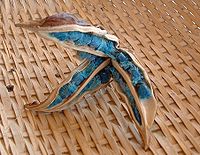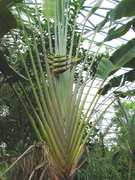| Ravenala madagascariensis | |
|---|---|

| |
| Conservation status | |
 Least Concern (IUCN 3.1) | |
| Scientific classification | |
| Kingdom: | Plantae |
| Clade: | Tracheophytes |
| Clade: | Angiosperms |
| Clade: | Monocots |
| Clade: | Commelinids |
| Order: | Zingiberales |
| Family: | Strelitziaceae |
| Genus: | Ravenala |
| Species: | R. madagascariensis |
| Binomial name | |
| Ravenala madagascariensis Sonn. | |
| Synonyms | |
| |

Ravenala madagascariensis, commonly known as the traveller's tree, traveller's palm or East-West palm, is a species of monocotyledonous flowering plant found in Madagascar. It is not a true palm but a member of the family Strelitziaceae.
Name
It has been given the name "traveller's palm" because the sheaths of the stems hold rainwater, which supposedly could be used as an emergency drinking supply for needy travellers. Another plausible reason for its name is that the fan tends to grow on an east–west line, providing a crude compass.
Description
The enormous paddle-shaped leaves are borne on long petioles, in a distinctive fan shape aligned in a single plane (distichous). The large white flowers are structurally similar to those of its relatives, the bird-of-paradise flowers Strelitzia reginae and Strelitzia nicolai, but are generally considered less attractive, with a green bract. These flowers, upon being pollinated, produce brilliant blue seeds. In tropical and subtropical regions, the plant is widely cultivated for its distinctive habit and foliage. As the plant grows older, it progressively loses the lowest or oldest leaves and reveals a sturdy grey trunk. Of the four forms, varieties or subspecies, the largest is the "Bemavo", from the hills of eastern Madagascar, which can be 100 feet (30 metres) in height with a trunk 2 feet (60 cm) thick. The foliar fan consists of 30 to 45 leaves for mature specimens, each as much as 36 feet (11 metres) in length.
The chromosome number is 2n = 22.
Range and habitat
Ravenala madagascariensis is widespread in Madagascar, including humid lowland forests, montane forests, grassland, and rocky areas, from sea level to 1,500 meters elevation.
Ecology
Ruffed lemurs are a known pollinator of this plant, and given the size and structure of the inflorescences, as well as the lemur's selectivity, method of feeding, and long muzzle, this relationship is thought to have coevolved.
Cultivation
The plant requires a sunny spot (not full sun until it is larger). It responds well to fertiliser, especially if it is high in nitrogen during the growing season. This produces better growth and foliage. The plant grows to an average height of 7 m (23 ft) and requires moderate water.
Gallery
-
 Use in urban setting at Maui, Hawaii
Use in urban setting at Maui, Hawaii
-
In a park of Phnom Penh, Cambodia
-
 Seeds
Seeds
-
 Bark
Bark
-
 The old petioles dry out brown
The old petioles dry out brown
-
 Ravenala with spent inflorescence
Ravenala with spent inflorescence
References
- ^ Andriamanohera, A.M. (2021). "Ravenala madagascariensis". IUCN Red List of Threatened Species. 2021: e.T137831330A137904098. doi:10.2305/IUCN.UK.2021-1.RLTS.T137831330A137904098.en. Retrieved 7 September 2022.
- McLendon, Chuck (May 16, 2000). "Ravenala madagascariensis". Floridata.com. Retrieved September 14, 2009.
- Calley, M.; Braithwaite, R. W.; Ladd, P. G. (1993). "Reproductive Biology of Ravenala madagascariensis Gmel. as an Alien Species". Biotropica. 25 (1): 61–72. Bibcode:1993Biotr..25...61C. doi:10.2307/2388979. JSTOR 2388979.
- Das Pflanzenreich Volume 4 Issue 45 (1900) page 29
- "Protabase Published species". Archived from the original on 2010-05-04. Retrieved 2010-04-21. Then click "Ravenala madagascariensis"
- "Full text of "Chromosome Atlas Of Flowering Plants Ed. 2nd"". Internet Archive (in Latin). 2016-10-23. Retrieved 2019-07-09.
- Garbutt, Nick (2007). Mammals of Madagascar, A Complete Guide. A&C Black Publishers. pp. 170–175. ISBN 978-0-300-12550-4.
External links
| Taxon identifiers | |
|---|---|
| Ravenala madagascariensis |
|